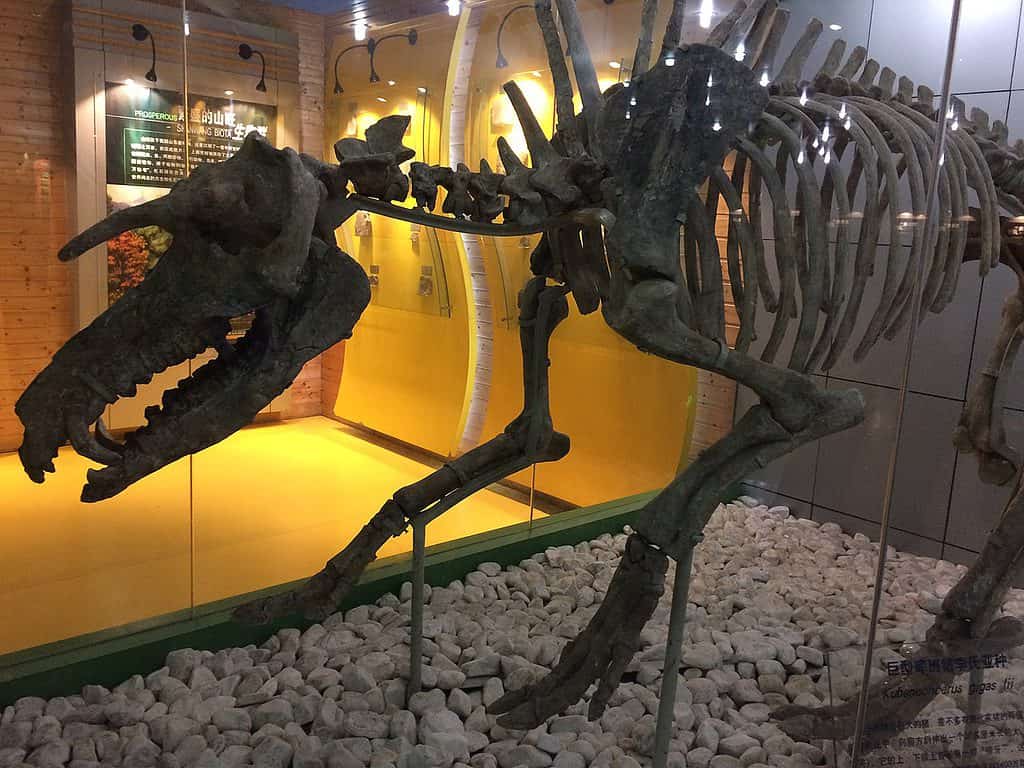Fossils are the best tools for learning about extinct creatures. The earliest fossils of animals in the Suidae family date back to the Oligocene epoch, around 23-33 million years ago. The Suidae family includes warthogs, farm pigs, and the babirusa. There are about 16-18 extinct species within the Suidae family. Let’s look at the now-extinct “Unicorn Pig” that weighed 1,000 pounds and had a horn on its head.
Kubanochoerus: the ‘Unicorn Pig’
Kubanochoerus is an extinct genus of long-legged pigs that lived during the early to middle Miocene period. Kubanochoerus gigas is the largest species in this genus and had a height of around 3.3 feet, and was estimated to be about 1,100 pounds. The skull of kubanochoerus had a large bony protrusion that came out the top of their head. Two smaller horns came out of their head, right above their eyebrows.
It is believed that only males had the unicorn-like horn that came from their heads. Jousting and attracting mates are possible uses of their horns. This animal had long legs and a robust pig-like body. Modern pigs and other ancient fossils of similar species were used to discover how this animal looked. Their size and the unicorn horn are their most identifying traits.
Discoveries and Fossils

A large cranial fossil with a horn-like protrusion was one of the most important discoveries that helped identify
Kubanochoerus gigas.
©Jonathan Chen / CC BY-SA 4.0 – License
The first fossils of Kubanochoreus were discovered in China in 1928. Initially, they were categorized into the Listriodon genus. Kubanochoerus was first described in 1955. The classification of fossils within the kubanochoerus genus has been highly controversial. China, Africa, and Eurasian countries are where fossils of this species have been uncovered. A large cranial fossil with a horn-like protrusion was one of the most important discoveries that helped identify Kubanochoerus gigas. Other teeth and mandibles fossils have also helped identify animals within the genus.
A debate has occurred about fossils discovered whether they should be classified within the genera of Libycochorues, Megalochorues, or kubanochoerus throughout the years. Kubanochoerus gigas is the largest in the genus, but other species included Kubanochoerus lantianensis, Kubanochoerus mancharensis, Kubanochoerus minheensis, Kubanochoerus parvus, and Kubanochoerus robustus. The discovery of better-preserved fossils and more studies in the future will help clarify the confusion about the ancient giant pigs.
Habitat
The largest species of kubanochoerus likely lived in open habitats, as its size protected it. Smaller species likely have lived in more densely forested areas with cover. Open woodlands, savannas, or a mix between the two are the habitats this species likely lived in. Kubanochoerus lived across Eurasia and Africa from the Burdigalian to the Tortonian stages of the Miocene period.
Diet – What Did Kubanobhoreus Eat?

The snout of the unicorn pig was not as good at rooting in the soil as modern pigs.
©Stanton F. Fink / CC BY-SA 2.5 – License
Kubanochoerus are believed to be mainly herbivorous animals, feeding on low-lying plant life. Modern pigs eat anything they come across, and it is thought the same was true for the unicorn pig. Meat could have been a part of their diet. While they are mainly foragers, they could have eaten smaller animals they come across or feasted on dead carcasses. The snout of the unicorn pig was not as good at rooting in the soil as modern pigs since their noses were not as advanced.
Threats and Predation
Threats the kubanochoerus faced in the wild would have included nimravids or false saber-toothed cats. Amphicyonids, or bear dogs, also likely preyed on this giant pig if they came across them, as well as true sabercats that came along later during the Miocene period. This pig had tusks to defend itself like modern pigs and its unicorn curved horn. While a variety of large predators lived during the Miocene, the kubanochoerus likely used its tusks and large horn to better compete with other pigs for food.
Similar Animals
Today there are multiple pig species, some bred for eating, while others live in the wild. Here are a few exciting pigs that you should know about.
- Giant Forest Hog: The giant forest hog is today’s largest pig species. They can reach up to 600 pounds and grow up to 3 feet in shoulder height. There are three subspecies of these pigs. They are restricted to Guinea and Congolese forests in Africa.
- Babirusa: This pig is also called the deer pig since they have large tusks that come out of their head that resemble a deer’s antlers. Their tusks or canine teeth grow both on their upper and lower snout. This pig grows up to 200 pounds.
- Pygmy Hog: This pig is the only one in the Procula genus and is currently the smallest pig species in the world. They grow between 14-20 inches at shoulder height, and adults only weigh around 18 pounds. Only about 200 of these pigs live in the wild and are endemic to India.
Up Next
- 10 Incredible Pig Facts
- Pig Lifespan: How Long Do Pigs Live?
- Hog vs. Pig: 6 Main Differences
- Discover the 10 Largest Pigs in the World
The photo featured at the top of this post is © Alex Uchytel / CC BY-SA 4.0 – License / Original
Thank you for reading! Have some feedback for us? Contact the AZ Animals editorial team.






